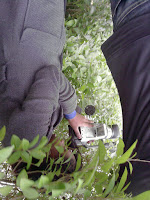When we initially started the project, we had Dhruv with us who was allocated the role of the editor. He had done quite a lot of editing and was actually a freelance editor. Unfortunately due to health reasons, he had to drop out of the course. I had done BTEC Level 2 in Media last year and I could use the editing software so I agreed to be the executive editor.
Final Cut Pro, a professional software programme, made by the Apple Inc. software is used in non-linear editing. Final Cut Pro logs and captures video on a hard drive from where it can be edited and processed. Non-linear editing is an advanced editing method that involves accessing any frame or shot in a digital video clip easily. It is similar to the ‘cut and paste’ method that we are so used to while working on a word document: we can cut and paste the videos wherever we want. After logging, the video tape (footage) is loaded onto a DV tape player from where the shots are imported (captured) on the computer. We can then start editing the footage. (The DV tape player is a firewire-a connection that allows exchanging data very fast.)
On the software, we’ve got a timeline where the visual and audio tracks are kept; sound is kept in an audio wave form (a pictorial representation of music). With a timeline we can see how long the chosen clips are; hence the word ‘time’line. The timeline in Final Cut Pro allows 99 video tracks to be layered on top of each other. The audio wave form helps to know the ups and downs in the song and therefore it’s very helpful to keep the video clips according to the musical beat which is also known as ‘cut to the beat’. The word ‘bin’ in this software denotes the space where the visual or audio tracks: footages are kept.
As this software has ‘cut and paste’ functions, we can do it for various visual clips with the use of Shortcut keys. ‘I’ key when pressed while the clip is running acts as a start or ‘in point’ and the ‘O’ key is the end button or the ‘out key’. So when we use those keys, we get a short clip from the original one which can be dragged to the timeline to go along with the soundtrack and this is done with respect to the musical beat. Other keys are: ‘J’ to rewind, ‘K’ to stop and ‘L’ to play and forward. To simplify this process, we have a ‘playhead’ which can be dragged to the left and right side of the clip and we can see the clip in a fast pace; the clip going quickly is called scrubbing. The spacebar is used to play and pause the video and the backspace is the delete button. For this software, it is beneficial if the user can use the mouse and the keyboard combined.
On the screen, we’ve got a tool bar at the bottom tight side where there are tools like magnifier to magnify the clips. There is a razor tool to cut the clips. On the canvas screen, we can watch the clip we made or are making, by copying and pasting the visual clips, along with the music whereas in the viewer screen we watch the original visual clip where we can use the ‘I’ and ‘O’ key to choose the part in the videos. The ‘roll tool’ in the tool bar helps to change a particular clip without altering other clips. The lock symbols on the left side of each track are called ‘locking tracks’ which are pressed to secure the item in that track so as not to mess it up.
Before ‘Capturing’ , I created a new folder in ‘Scratch’ disk>Sam>AS Media and named it ‘VithujanParisMizla Thriller’. To capture the footage, I clicked on ‘File>Log & Capture’ (Shortcut keys= Cmd-8) after which we can view the visual on the computer screen. Before starting the ‘log and capture’, we are supposed to select the file where we want to keep all our footage. Hence, we need to click on ‘Preview>Capture Settings>Scratch Disk-Set’ and select the folder we made. This saves the project and all the footages in our folder while capturing. To select the footage, I clicked on ‘Now’ at the bottom of the video screen and ‘Esc’ to stop the capturing. I named each captured clip/footage according to what I’d written on my Tape Log Sheet.
Final cut pro has 150 effects available, for example, Glow, Light Rays, Outer Glow, Desaturate etc. There are video transitions like Cross Dissolve, Additive Dissolve and it also has audio transitions and audio filters such as keying tools, mattes and vocal de-poppers and de-essers. We learnt how to ‘close the gaps’ between the footages in the time-line and how to change the volume in a certain part of the same clip by using the ‘razor tool’ and altering the red line in the audio track. For this we used the Toggle Clip Overlays button which brought the volume line in the track. We used effects like Cross Fade (0db) in the audio transition for a smoother flow of the sound.
We were also introduced to Master Templates and told about PAL and NTSC: we are meant to use PAL because the other one is used by US Television Companies. But we decided to use Adobe AfterEffect and just the plain texts to make our titles.
Though I had used this software a few times to edit my BTEC projects, I still learnt a few new things and got a chance to refresh old memories. I helped Paris and Vithujan to understand the software and answered the questions they asked. Although, I was in charge of the post-production work, we three, as a group, decided what footage to use and where they belong and so on.
